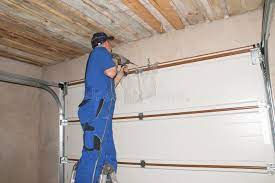
A Comprehensive Guide to Garage Door Replacement
A garage door is more than just an entryway; it’s a significant element of your home’s security, curb appeal, and overall functionality. Over time, wear and tear, outdated designs, or changes in your home’s aesthetic preferences may necessitate a garage door replacement. Understanding the process and benefits of replacing your garage door can help ensure you make an informed decision and achieve the best results.
When to Consider Garage Door Replacement
Several factors can indicate it’s time to replace your garage door:
1. Age and Wear: Garage doors typically have a lifespan of 15-30 years, depending on the material and maintenance. If your door is nearing or exceeding this age range and showing signs of wear, replacement might be a more cost-effective solution than continuous repairs.
2. Frequent Repairs: If you find yourself frequently repairing the garage door or its components, it may be more economical to replace the door rather than invest in ongoing repairs. Frequent breakdowns can indicate underlying issues that a new door could resolve.
3. Aesthetic Updates: A new garage door can significantly enhance the curb appeal of your home. If you’re updating your home’s exterior or looking to modernize its appearance, a new door can complement and elevate your home’s design.
4. Energy Efficiency: Older garage doors may lack modern insulation technologies, leading to higher energy costs. Replacing your door with an energy-efficient model can improve insulation, reduce heating and cooling expenses, and enhance comfort.
5. Safety and Security: Modern garage doors come equipped with advanced safety features, such as automatic reversing systems and improved security measures. If your current door lacks these features, replacement can enhance the safety and security of your home.
Benefits of Garage Door Replacement
1. Enhanced Aesthetics: A new garage door can transform the look of your home. With a variety of styles, materials, and colors available, you can select a door that complements your home’s architectural style and boosts its overall curb appeal.
2. Improved Functionality: Newer garage doors are designed for smoother operation and greater reliability. They often come with advanced technology and features that ensure quiet and efficient performance.
3. Increased Property Value: Upgrading your garage door can increase the resale value of your home. A modern, well-maintained door can be a selling point for potential buyers, making your property more attractive in the real estate market.
4. Enhanced Safety and Security: Modern garage doors are equipped with advanced safety features, such as rolling code technology and automatic reversal systems. These features provide improved protection for your family and property.
5. Energy Efficiency: New garage doors often include better insulation, which can help maintain your home’s temperature and reduce energy costs. Improved insulation also contributes to a quieter and more comfortable living environment.
The Garage Door Replacement Process
1. Assessment and Selection:
o Consultation: Begin with a consultation to discuss your needs, preferences, and budget. A professional can help you understand your options and choose a door that fits your home’s style and functionality requirements.
o Measurement: Accurate measurements of your garage door opening are essential for selecting the right size and ensuring proper fit and operation of the new door.
2. Removal of the Old Door:
o Disassembly: The old garage door and its components are carefully disassembled and removed. This process includes removing the tracks, springs, and any attached hardware.
3. Installation of the New Door:
o Preparation: The installation area is prepared to ensure a proper fit for the new door. This may involve adjustments to the door frame or structural modifications.
o Mounting: The new door is mounted, and its tracks, springs, and hardware are installed according to manufacturer specifications. This step ensures the door operates smoothly and efficiently.
4. Final Adjustments and Testing:
o Alignment and Balance: The door is aligned and balanced to ensure optimal operation. This includes adjusting the springs and checking the door’s movement.
o Safety Features: Safety features, such as sensors and automatic reversing systems, are tested to ensure they function correctly.
5. Inspection and Clean-Up:
o Final Inspection: A thorough inspection is conducted to verify that the installation meets all standards and that the door operates properly.
o Clean-Up: The work area is cleaned, and any debris from the old door is removed.
Conclusion
Garage door replacement is a significant investment that can enhance the security, functionality, and appearance of your home. By understanding when and why to replace your garage door, you can make informed decisions that align with your needs and preferences. Professional installation ensures that the new door is fitted correctly and operates smoothly, providing long-term benefits and improving the overall value and comfort of your home.

